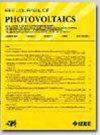用于建筑集成光伏的电压匹配全钙钛矿双结和三结太阳能组件
IF 2.6
3区 工程技术
Q3 ENERGY & FUELS
引用次数: 0
摘要
我们设计了安装在建筑墙体上的多结太阳能组件,其中所有子模块都由有机-无机混合钙钛矿太阳能电池组成,采用单片串联互连结构。在考虑具体组件配置之前,我们阐明了太阳光谱的时间和区域变化对垂直安装在墙壁上的组件的影响比安装在屋顶和太阳能农场的组件的影响更显著。因此,传统双端配置的双结(2J)模块和其他需要上下模块之间电流匹配的配置的年平均转换效率显著降低。相比之下,电压匹配(VM) 2J模块,其中产生大致相同的最大功率电压(VMP)的子模块并联连接,即使在墙壁安装时也能确保接近四端(4T) 2J模块的高转换效率,因为VMP对太阳光谱变化的敏感性低于光电流。VM 2J模块的单输出实际上比4T 2J模块的双输出有很大的优势。一种改进型:串并联VM三结模块,其中两端的中/下模块与顶部模块并联,进一步提高了各种安装条件下的转换效率。本文章由计算机程序翻译,如有差异,请以英文原文为准。
Voltage-Matched All-Perovskite Double- and Triple-Junction Solar Modules for Building-Integrated Photovoltaics
We designed multijunction solar modules for installation on building walls, in which all the submodules are composed of organic–inorganic hybrid perovskite solar cells, adopting the monolithically series-interconnected structures. Prior to considering concrete module configurations, we elucidated that the impacts of temporal and regional variations in the solar spectra on the vertically wall-installed modules are more notable than those on the modules installed on rooftops and in solar farms at the optimal tilt angles. As a result, the annually averaged conversion efficiencies for the double-junction (2J) modules of the conventional two-terminal configuration and other configurations that require the current matching between the top and bottom modules are notably degraded. By contrast, the voltage-matched (VM) 2J modules, in which the submodules yielding approximately the same maximal-power voltages (VMP) are connected in parallel, ensure high conversion efficiencies close to those for the four-terminal (4T) 2J modules even when wall installed because VMP is less sensitive to solar-spectrum variation than the photocurrents. The single output of the VM 2J modules is practically a great advantage over the dual output of the 4T 2J modules. An improved variant: the series–parallel-connecting VM triple-junction modules, in which the two-terminal middle/bottom modules are parallel connected with the top modules, further improve the conversion efficiencies under all the installation conditions.
求助全文
通过发布文献求助,成功后即可免费获取论文全文。
去求助
来源期刊

IEEE Journal of Photovoltaics
ENERGY & FUELS-MATERIALS SCIENCE, MULTIDISCIPLINARY
CiteScore
7.00
自引率
10.00%
发文量
206
期刊介绍:
The IEEE Journal of Photovoltaics is a peer-reviewed, archival publication reporting original and significant research results that advance the field of photovoltaics (PV). The PV field is diverse in its science base ranging from semiconductor and PV device physics to optics and the materials sciences. The journal publishes articles that connect this science base to PV science and technology. The intent is to publish original research results that are of primary interest to the photovoltaic specialist. The scope of the IEEE J. Photovoltaics incorporates: fundamentals and new concepts of PV conversion, including those based on nanostructured materials, low-dimensional physics, multiple charge generation, up/down converters, thermophotovoltaics, hot-carrier effects, plasmonics, metamorphic materials, luminescent concentrators, and rectennas; Si-based PV, including new cell designs, crystalline and non-crystalline Si, passivation, characterization and Si crystal growth; polycrystalline, amorphous and crystalline thin-film solar cell materials, including PV structures and solar cells based on II-VI, chalcopyrite, Si and other thin film absorbers; III-V PV materials, heterostructures, multijunction devices and concentrator PV; optics for light trapping, reflection control and concentration; organic PV including polymer, hybrid and dye sensitized solar cells; space PV including cell materials and PV devices, defects and reliability, environmental effects and protective materials; PV modeling and characterization methods; and other aspects of PV, including modules, power conditioning, inverters, balance-of-systems components, monitoring, analyses and simulations, and supporting PV module standards and measurements. Tutorial and review papers on these subjects are also published and occasionally special issues are published to treat particular areas in more depth and breadth.
 求助内容:
求助内容: 应助结果提醒方式:
应助结果提醒方式:


